-
Armed Regulation
Armed Drill team is one of the toughest teams to participate in. Its members are some of the best drillers in the entire unit. They work hard to secure their position on the team and grow their skills so the team as a whole may continue to grow and do more complex drill movements.
Armed Drill Team, like the Unarmed Drill Team, does two types of drill, regulation and exhibition. Regulation is marching while doing organized military movements with accuracy, bearing, and discipline. The routine consists of military movements done by the command of the commander. It takes practice and focus to do this on a competitive level and will be a strong focus of the team over the school year.
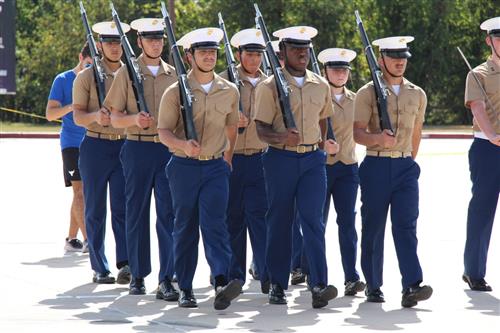
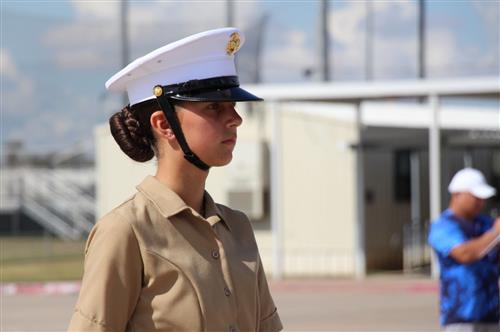
-
Armed Exhibition
Armed Drill team is one of the toughest teams to participate in. Its members are some of the best drillers in the entire unit. They work hard to secure their position on the team and grow their skills so the team as a whole may continue to grow and do more complex drill movements.
The second type of drill, exhibition, is the more free thinking, creative drill. It involves the spinning and manipulation of the rifle mixed with complex movements within the drill team to create amazing routines carefully designed to surprise and impress the judges. This takes ten times as much practice as regulation and comes faster to some than others, but with the help of experienced drill team members who are very willing to help you perfect your skills, you will be able to eventually do difficult spins with ease. Lots of coordination and endurance are needed in order to be able to do this and it doesn't matter if you don't have this. Over time, you will grow stronger and be able to do things you thought you couldn't.
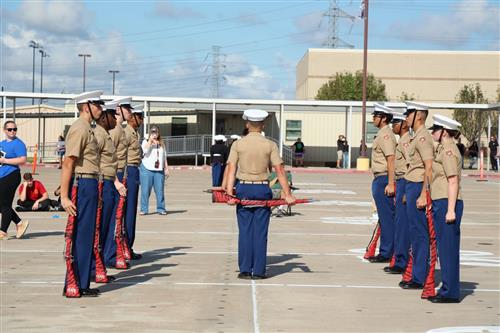
-
Unarmed Regulation
What is Unarmed Drill Team?Unarmed is one of three drill teams offered through Travis MCJROTC Similar to the Armed Drill Team, it consists of a 9-person platoon. We participate in both regulation and exhibition drills during area, state, and nation-wide competitions. Cadets on Unarmed must show exceptional vigor and a drive to learn.
Drilling:
The two drills that Unarmed participates in are regulation and exhibition. Regulation drill consists of both in-place and marching. During this, the platoon executes commands called by the commander with sharpness and bearing. This includes columns, flanks, faces, etc. Cadets are expected to learn and master these movements as well as perform them accurately during practice and competitions.
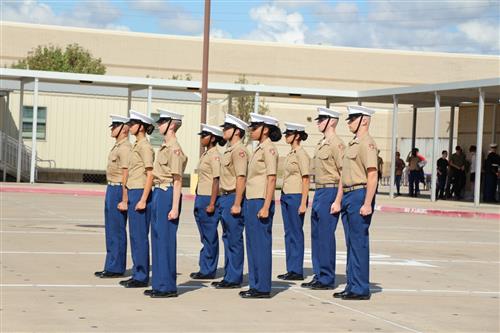
-
Unarmed Exhibition
Exhibition is another aspect of unarmed drill. This portion is less “by the book” and more creative and fun. Instead of spinning and tossing rifles, we use our hands and feet to make a beat. During exhibition, we perform a marching routine with flair and attitude while still incorporating key military aspects. This portion is immensely more challenging than regulation, but is also more rewarding. Exhibition is what sets our school apart from the others.
While both aspects of unarmed drill may seem challenging, coming to practice will teach you all there is to know about drilling, plus more!
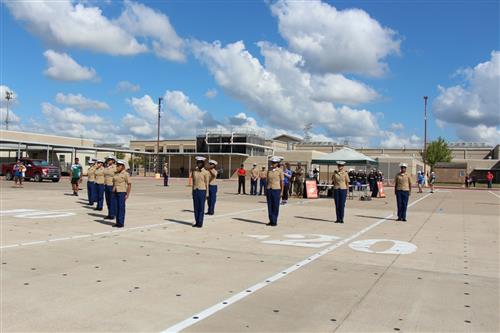
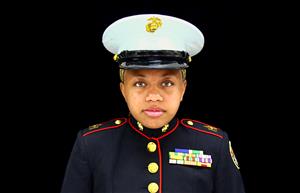
-
Color Guard
Color Guard isn’t for everyone. It demands time, unwavering commitment, and a mindset forged by discipline. This is not just another Drill team — this is the most elite, most visible, and most exacting unit in the program. We don’t just show up — we lead from the front. We are the face of the battalion, the standard by which the rest are judged. When the colors are presented, all eyes are on us. Failure is not an option — and mediocrity has no place here.
Each formation consists of only four members: two rifle guards, two flag bearers — United States and Marine Corps. With so few of us on the deck, every movement, every breath, every mistake is magnified. Precision isn’t recommended — it’s required. That’s why we drill relentlessly. Hours of repetition, correction, and refinement go into every second of our performance. We hold multiple practices each week, and we push harder in the days leading up to competitions. Even then, we’re not done — we still show up to community events, ceremonies, and parades, often multiple times per week. If you think you’re tired, you’re not ready yet.
We don’t just perform — we represent. Our award-winning Honor Guard takes this responsibility even further. This elite extension of Color Guard travels across the region, performing ceremonial duties at high-level public and military events. When the national anthem is played, we stand front and center — crisp, silent, flawless. We are called upon by name because we deliver perfection, every time. This is not something you sign up for — this is something you earn. And only the best of the best will ever wear that ribbon.
Color Guard is a brotherhood — a family forged under pressure, built on mutual respect and shared sacrifice. We support each other, we train each other, and we hold each other accountable. There are no excuses on this team. If you step into this unit, you will be expected to give your best at all times. We don't accept passengers — only performers.
Color Guard is a privilege. And if you want to wear that uniform and carry those colors, you’ll earn it. We demand nothing less than excellence.
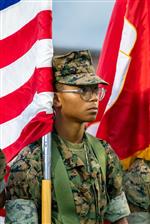
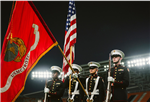
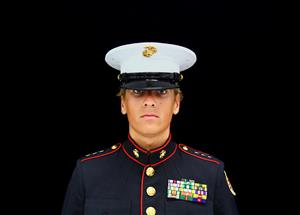
-
Inspection
The Junior ROTC Unit Inspection Program is used to evaluate JROTC units to determine if the schools, cadet corps, and instructors meet and maintain program standards. Identify and appropriately reward those that exceed minimum program standards. JROTC units will be inspected by uniformed personnel or retirees and reservists/NG personnel authorized to wear the uniform and who meet height-weight standards.
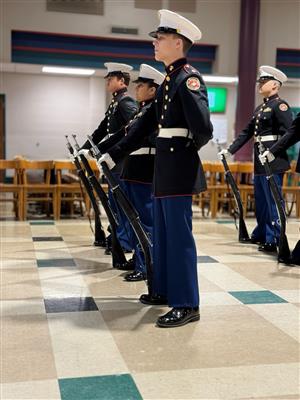
-
Academics
The JROTC program is designed to teach high school students the value of citizenship, leadership, service to the community, personal responsibility, and a sense of accomplishment, while instilling in them self-esteem, teamwork, and self discipline. This lesson reviews the birth of the JROTC program as well as its purpose of enabling students to meet their goals for success.
The academics test covers this knowledge along with various Marine Corps and US history.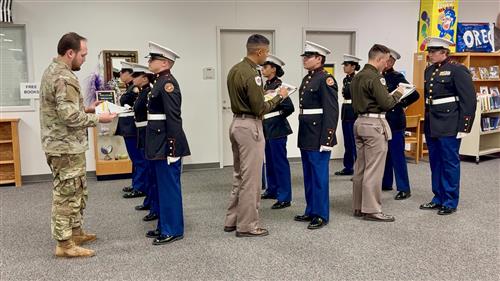
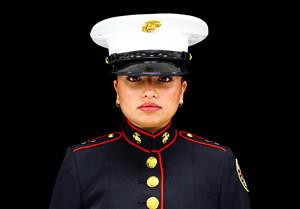
-
PT
Our goal in PT is to show up to every competition and do the most sit-ups or push-ups as well as run the fastest. Although winning is definitely a goal that we strive for, PT is mostly about being able to push yourself to become stronger and better than you were before. Working out may not always be the most fun thing to do, but you can be motivated by doing PT with your friends and pushing each other to be better and stronger. You will never regret investing time into your health and fitness. You will look good, feel good and have a lot of fun while you are at it.
-
Marksmanship
The type of rifle marksmanship that is taught and practiced in the JROTC program is three-position air rifle shooting that is done with 4.5 mm (.177 cal.) air rifles with the targets placed at a distance of 10 meters. JROTC riflery was once done with .22 cal. rim fire rifles with the targets placed at a distance of 50 feet. Three-position air rifle target shooting that is done by JROTC cadets is closely related to the air rifle standing and three-position smallbore rifle events that are in the program of the Summer Olympic Games.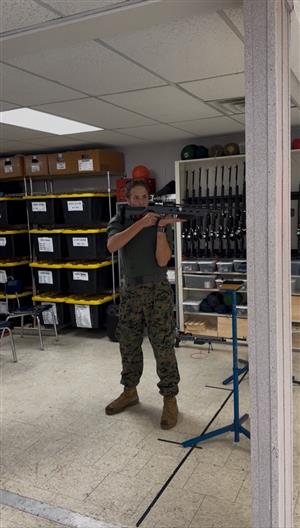
-
Raider's Team
The Raider Team is for those cadets who wish to challenge their physical endurance, mental strength, and their leadership. The cadets who participate in Raider team will strengthen their leadership, improve on their fitness, and participate in competitions against other school's Raider teams.
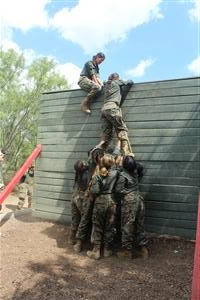
Select a School...
Select a School
- Fort Bend Education Foundation
- Austin High School
- Bush High School
- Clements High School
- Dulles High School
- Hightower High School
- Kempner High School
- Elkins High School
- Marshall High School
- Ridge Point High School
- Travis High School
- Willowridge High School
- Progressive High School
- James Reese Career and Technical Center
- Baines Middle School
- David Crockett Middle School
- Dulles Middle School
- Hodges Bend Middle School
- James Bowie Middle School
- Lake Olympia Middle School
- First Colony Middle School
- Fort Settlement Middle School
- Garcia Middle School
- McAuliffe Middle School
- Missouri City Middle School
- Quail Valley Middle School
- Sartartia Middle School
- Sugar Land Middle School
- Ronald Thornton Middle School
- M.R. Wood Center for Learning
- Ridgemont Early Literacy Center
- Hunters Glen Early Literacy Center
- Allen Aldridge Jr. Elementary
- Anne McCormick Sullivan Elementary
- Arizona Fleming Elementary
- Austin Parkway Elementary
- Barbara Jordan Elementary
- Barrington Place Elementary
- Brazos Bend Elementary
- Carolyn and Vernon Madden Elementary
- Colony Bend Elementary
- Colony Meadows Elementary
- Commonwealth Elementary
- Cornerstone Elementary
- Donald Leonetti Elementary
- Dulles Elementary
- Dr. Lynn Armstrong Elementary
- E. A. Jones Elementary
- Edgar Glover Jr Elementary
- Heritage Rose Elementary
- Highlands Elementary
- Hunters Glen Elementary
- James C. Neill Elementary
- James Patterson Elementary
- Jan Schiff Elementary
- Juan Seguin Elementary
- Lakeview Elementary
- Lantern Lane Elementary
- Lexington Creek Elementary
- Lula Belle Goodman Elementary
- Malala Yousafzai Elementary
- Mary Austin Holley Elementary
- Meadows Elementary
- Mission Elementary
- Mission West Elementary
- Oakland Elementary
- Oyster Creek Elementary
- Palmer Elementary
- Rosa Parks Elementary
- Pecan Grove Elementary
- Quail Valley Elementary
- Ridgegate Elementary
- Ridgemont Elementary
- Rita Drabek Elementary
- Scanlan Oaks Elementary
- Settlers Way Elementary
- Sienna Crossing Elementary
- Sugar Mill Elementary
- Townewest Elementary
- Walker Station Elementary
- Walter Moses Burton Elementary
- Almeta Crawford High School
- Alyssa Ferguson Elementary
- Sonal Bhuchar Elementary
- Ferndell Henry Elementary
- Briargate Elementary
- Mission Bend Elementary

